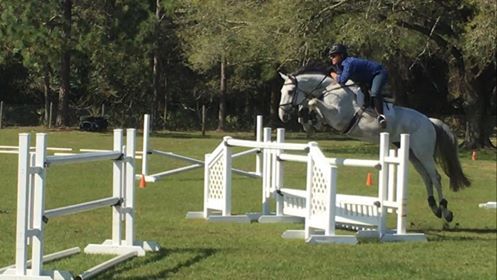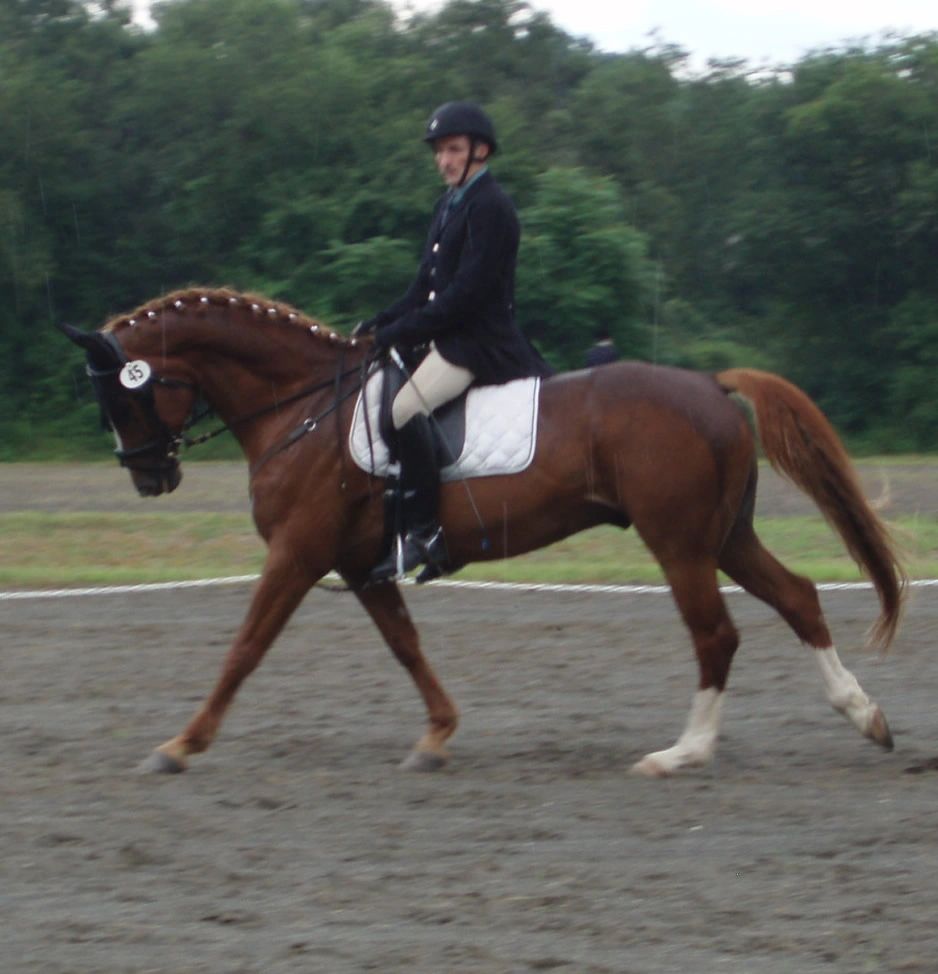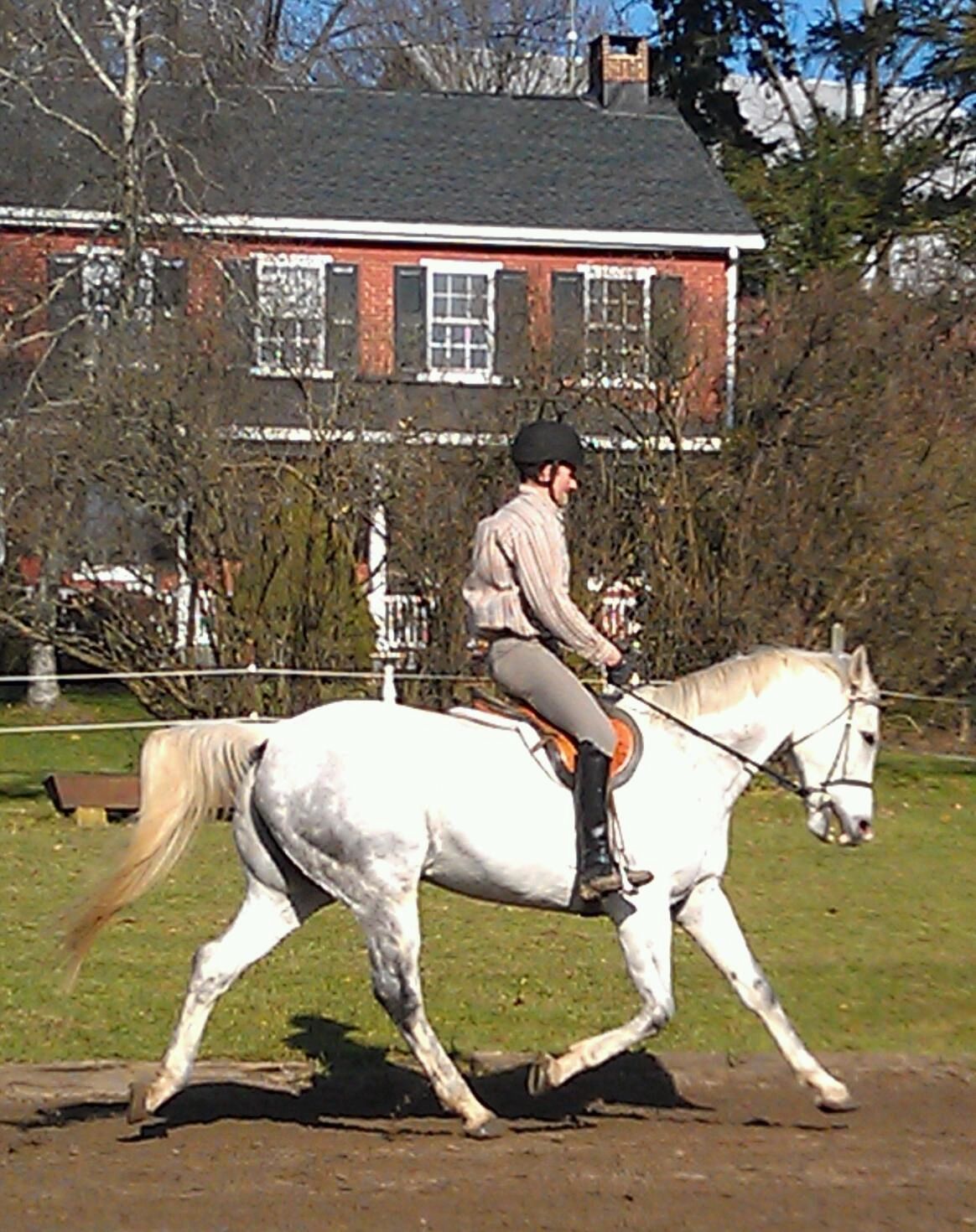Testimonials

"The BarebackDressage kit provides several great tools which, along with Candace's methodology, dramatically accelerates learning time, while reducing stress on horses, riders and instructors. When it comes to training, more advanced hunter and jumper professionals can quickly master and feel how dressage basics improve a horse's performance over fences."
- Dustin Durham, Grand Prix Jumper Professional

In this photo, Linette is riding shortly after carpal tunnel surgery, hence her longer reins, but very light contact at medium trot (no strain on her surgery). Linette and her FEI mare benefited tremendously from the Bareback Dressage Pad.
Linette – FEI level rider and trainer
"I try to school my horse doing bareback dressage at least once a week. I'm amazed at the advantages it enables...a true closeness to the horse with much lighter use of the aids. Bareback dressage gives your horse the ultimate freedom for movement! I also found that it helps with further development of your core balance, ie; you must be sitting completely balanced in order to do tempi changes bareback!"
Jennifer – Experienced Hunter/Jumper, Avid Fox Hunter

"I've been a fox hunter for 34 years. I'd never thought, nor had been
told that dressage would help my horses (and me). After I loaned Candace
my wonderful first flight mare, Tabasco, for a 3 hour trail ride,
Candace was all about offering Tabasco and me a better way. Tabasco had a
long running trot where she hollowed her back and covered some ground,
not providing a comfortable ride, nor helping herself last longer.
Tabasco was also having a sore back more and more frequently due to
arthritic changes in her hocks. After one (dramatic, but very
successful) longe session in side reins, Tabasco "got it" and then
Candace completed the session mounted, getting Tabasco to round, use her
back correctly and go on the bit.
After the session with Tabasco, I
rode my OTTB bareback with his incredibly high withers, and I easily
felt what was correct to do to get him round and on the bit - it was
FANTASTIC! I could feel on him what I wasn't able to feel and ask for on
Tabasco. His high withers almost polished me off. (I am looking forward
to the BB pad that Candace swears by.) By the end of the week, Tabasco
was on the bit at a walk and trot, and picking up a balanced canter from
the lightest leg aid. It was an INCREDIBLE week to feel on the OTTB,
ask and get lovely collection at all three gaits, then move to correctly
asking Tabasco. It totally transformed the second half of the hunt
season for me.
Best of all for Tabasco, now that she is using herself
correctly, the back soreness has not shown itself again!"
Margaret – Instructor, specializing in special needs and learning disabled riders:
"Riding bareback? Scary concept. Bareback dressage? Even scarier concept. Yet both are very beneficial with regards to balance and feel for rider and horse. Throw in self confidence and trust and what a wonderful feeling of success!
The Candace Clemens' methodology has worked not only for me but for my horses and students.
· One student was resistant to having the side reins attached, however when she realized the horse accepted the bit and thus became less tight and stiff in the back and she had a horse willing to move forward she has been able to focus on her balance and feel.
Another student was also resistant to the side reins but now has a horse that is on the bit and moving with more fluidly under saddle with less effort on the rider’s part.
Due to increased balance and confidence from riding bareback with side reins, this rider is now able to jump bareback -- no side reins. As we have discussed side reins are not usually recommended for jumping, although for low cross rails, if set at a proper length, they can help some horses stay round. I make sure all my lesson horses are “tested” safe to be ridden in side reins before using them as 'training wheels' for my novice riders.
As for myself…..my balance has improved to the point I can canter and jump my horse bareback! However, as Candace noted, if my back condition flairs up, and I feel sore, I need to go back to the saddle. My sore back can irritate my horse if I try to ride bareback at the canter, his more difficult gait to collect."
Later update from Margaret on her students’ progress:
"B. has had maybe 6 lessons with me. He's use to riding at [other equestrian establishment] holding on to a neck strap thus pitched forward----similar to M. when she started taking lessons from me. He's also use to kicking and cropping to get the former lesson horse to move thus equitation skills go by the wayside by constantly being off balance due to cow kicking and the inconsistent rhythm of the horse.
I will be putting B. on Ritzen bareback in the not to distant future and naturally doing before and after videos. Ritzen is not proven safe to be ridden with side reins, so they will not be used."
Anita – Novice rider in her mid-60’s, two hip replacements, having just purchased her first horse, an unbroken, recently gelded 15 year old Morgan.

"A few thoughts about riding bareback...so far, since I only started riding using the BarebackDressage Kit recently:
1. More aware of centered position over the horse's back providing a more secure seat and awareness of lateral imbalances;
2. Not depending upon stirrups allows me to maintain a deeper seat;
3. Awareness of sitting back with gait changes rather than pitching forward allows for smoother transitions;
4. Ability to feel whether horse is relaxed or annoyed with my aids by his back movement;
5. While I know you take them off after I do my warm up, I always use side reins when you are not available to supervise, because Majesty never does anything dangerous when he is in side reins. I still make mistakes and annoy him, but he doesn’t do what he used to do before you introduced the side reins – buck me off. And, I can always go back to letting him reach down into the side reins, which always returns him to a happy attitude.
I'm always very thankful for all the help...praise and criticisms... both of you have given me. If you asked me 1 year ago if I'd be practicing dressage movements, I would have said "Oh yeah, SURE." - Anita
Joe – Originally a novice hunt seat rider. Now winning championships at hunter shows, and able to compete at third level dressage, and rapidly becoming a good trainer himself.

Joe was a share-leaser for many years of Star, the FEI horse I trained for a friend of mine. He had many years of instruction in Hunt Seat. As a result, he tended to tip forward and was always in front of Star’s center of balance. He is 6’ tall, and she is a tiny, 15.1, weedy Arab/Saddlebred cross. As long as he tipped forward, she’d stick her head up in the air, and was unable to collect her gaits. And her back got stiff and sore any time he rode. All Star’s other riders could tell after Joe rode, because she’d toss her head. He was unable to establish an elastic connection with his hands.
Because he was a guy, I did not ask him to ride bareback, but had him work without stirrups a lot, but even that didn’t work very well. Joe is a very fit, toned man, and had trouble letting his tight muscles relax.
After working with Joe about once a week for two years, I had to take a year off from the barn. My parting words to Joe, “Just ride bareback for a year. Do whatever you must to make her feel comfortable. She will teach you.”
Six months later, I met him at the barn, just to see how he was doing. BINGO….Star was on the bit, her gaits collected, and he could sit all three gaits beautifully. No tipping forward, his back totally connected with her back. No more head tossing by Star.
HOWEVER….I had not yet discovered an acceptable bareback pad. So he just rode pure bareback. And Star developed a small lump on her spine. It did not cause her any discernible discomfort while being ridden, though. Still, another advanced share-leaser felt that it might be causing Star some problems under saddle. Introducing the suede bareback pad seemed to solve the problem. But the “Boy Scout belt” girth slipped both laterally and, while being ridden, allowed the pad to slide backwards towards her loins. I added a breast collar which helped prevent the backwards slip.
With the help of my local tack shop owner, I managed to find a bareback pad that had both the stickiness of the suede pad, but had a comfortable and stable girth. And this, along with many, many riders – in addition to Joe – who learned from Star how to go on the bit, and how to sit the trot and canter in record time, gave me the idea for “The BarebackDressage™ Kit.”
Joe was able to take all he learned from riding Star and apply it to his Hunt Seat performance. He has gone on to win several reserves and championships at many horse shows and in good company, riding different horses, not trained in dressage.

This mare was approaching FEI. The greatest challenge for owner/rider Linette was learning to allow her mare to go in self-carriage, especially at the canter. Self carriage is another benefit of testing your horse doing Bareback Dressage. In just one session of working her horse in self carriage at the canter, this mare did a series of flawless 4, 3 and then seven 2-tempi changes. (Her first time doing tempi changes.) In this photo, Candace is on board enjoying the product of her rider's work -- lightness to leg and hand, and self carriage at the canter while gliding through an impressive half pass.

Candace on Watson, competing at PSG. Bareback Dressage made a dramatic difference in helping Watson learn to relax in new environments. In this class, a huge windstorm had blown in, causing tents to collapse and forcing the judges into cars to score each test. Many other horses were freaking out. Watson, who previously had been explosive in such conditions, especially when away from home, actually was complimented by the ring steward. As he stood quietly waiting "on deck," the steward said, "Your horse is the best behaved horse I've seen this morning." In addition to his mental relaxation, the Bareback Dressage Pad made his huge trot sit-able.

After riding an FEI horse Bareback for a year, Joe's position became dramatically more secure and independent from his hands. Subsequently, he became more confident and assertive as a rider and a trainer. Here he is pictured here on a temperamental TB with no dressage background. It was Joe's second time on this horse. Candace was busy working with another horse, paying no attention to Joe and what she thought was a very small moving TB with a bad attitude. But she turned around to see Joe getting an amazing lengthened trot from what she considered to be a horse with no potential for dressage. Of note: Candace was thrilled to see that Joe had become a trainer. (Note: a flash nose band was added the next day. This horse was schooling third level within a few months.)
Our weedy little half-Arab, share-leased, FEI mare, Star, making her debut with Candace at Intermediare. She always tended to break behind the poll, either bareback or under saddle. However, this former ring-sour, saddle seat mare loved her dressage work. And, with the help of a bareback pad and side reins, taught many rank beginners how to trot and canter on the bit, usually within two or three sessions. And anyone who already knew how to go on the bit could get on Star and practice tempi changes, Passage and Piaffe. But, unless the rider could get her truly engaged behind, there was no extended trot. She could "fake" one with a saddle, but Bareback always let the rider know if she was truly elastic and engaged behind.

I had the honor of riding with Robert Dover for a winter season in Florida, as well as watching him train many horses. I have no idea if Robert ever rode bareback, but I love this photo in which he provided my students with a great example of balance and relaxation, especially of the leg. These are some of the quickly learned benefits from Bareback Dressage. If you try to stay on by gripping with your legs, you quickly discover, not only does it not work for long, it will either dull or annoy the horse. Robert is brilliant at helping tense horses relax, and sitting in total harmony and balance with even the most challenging horses.

Candace jumping her first FEI horse, Kim Kam. While preparing Kim for her first Musical Freestyle (PSG), short on time, Candace climbed on bareback just to run through the choreography. All was well until the extended trot. Kim's extensions were enormous and very powerful. Candace nearly bounced off, and realized that, under saddle, she had not noticed some subtle stiffness in Kim's back. She rode Kim bareback for the next four days until the extended trot was comfortable, straight and springy and in self carriage.

Ridden by several share-leasers of different levels, mostly bareback, Star is shown here warming up for her first Intermediare Test. She needs to be more up at the poll in this photo. But her back was soft and relaxed.

Candace on Kim Kam's powerful extended trot at the Third Level Regional Finals. Thankfully, a Bareback Session helped alleviate some of the tension in this explosive mare's back because Candace was four months pregnant at the time of this photo. (Photo by Sue Sexton.)
Note From Karen, a dressage instructor in the Brewster area of New York, after trying out the BarebackDressage Kit:
